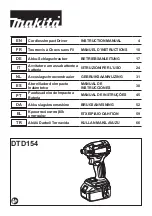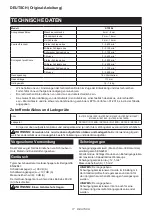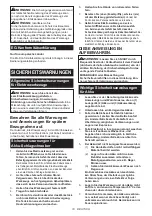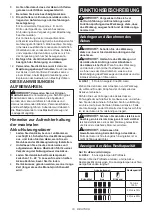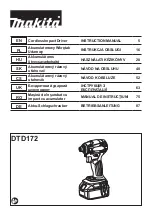
4 ENGLISH
ENGLISH (Original instructions)
SPECIFICATIONS
Model:
DTD154
Fastening capacities
Machine screw
4 mm - 8 mm
Standard bolt
5 mm - 16 mm
High tensile bolt
5 mm - 14 mm
No load speed
Hard impact mode
0 - 3,600 min
-1
Medium impact mode
0 - 2,100 min
-1
Soft impact mode
0 - 1,100 min
-1
T mode
0 - 3,600 min
-1
Impacts per minute
Hard impact mode
0 - 3,800 min
-1
Medium impact mode
0 - 2,600 min
-1
Soft impact mode
0 - 1,100 min
-1
T mode
0 - 2,600 min
-1
Rated voltage
D.C. 18 V
Overall length
117 mm
Net weight
1.2 - 1.6 kg
•
Due to our continuing program of research and development, the specifications herein are subject to change
without notice.
•
Specifications may differ from country to country.
•
The weight may differ depending on the attachment(s), including the battery cartridge. The lightest and heavi
-
est combination, according to EPTA-Procedure 01/2014, are shown in the table.
Applicable battery cartridge and charger
Battery cartridge
BL1815N / BL1820 / BL1820B / BL1830 / BL1830B / BL1840 /
BL1840B / BL1850 / BL1850B / BL1860B
Charger
DC18RC / DC18RD / DC18RE / DC18SD / DC18SE / DC18SF
•
Some of the battery cartridges and chargers listed above may not be available depending on your region of
residence.
WARNING:
Only use the battery cartridges and chargers listed above.
Use of any other battery cartridges
and chargers may cause injury and/or fire.
Intended use
The tool is intended for screw driving in wood, metal
and plastic.
Noise
The typical A-weighted noise level determined accord
-
ing to EN62841:
Sound pressure level (L
pA
) : 96 dB(A)
Sound power level (L
WA
) : 107 dB (A)
Uncertainty (K) : 3 dB(A)
The noise level under working may exceed 80 dB (A).
WARNING:
Wear ear protection.
Vibration
The vibration total value (tri-axial vector sum) deter
-
mined according to EN62841:
Work mode: impact tightening of fasteners of the maxi
-
mum capacity of the tool
Vibration emission (a
h
) : 12.5 m/s
2
Uncertainty (K) : 1.5 m/s
2
NOTE:
The declared vibration emission value has
been measured in accordance with the standard test
method and may be used for comparing one tool with
another.
NOTE:
The declared vibration emission value
may also be used in a preliminary assessment of
exposure.

